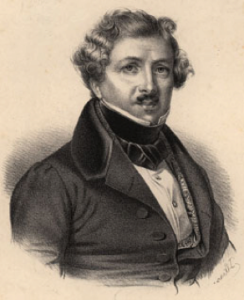Well, for starters, we know he was a SWSM from France. Yes, SWSM stands for “single, white, straight male” whose occupation is listed as an inventor and photographer.
Born on November 18,1787, Louis-Jacques-Mandé Daguerre is best known for inventing the Daguerreotype. A form of photography and a process which was “a one-of-a-kind image on a highly polished, silver-plated sheet of copper,” according to www.metmuseum.org.

Louis-Jacques-Mandé Daguerre
In addition, “… it was sensitized with iodine vapors, exposed in a large box camera, developed in mercury fumes, and stabilized (or fixed) with salt water or “hypo” (sodium thiosulphate).”
And although Daguerre was required to reveal certain details involving the process, “he wisely retained the patent on the equipment necessary to practice the new art.”
However, “Daguerre’s invention did not spring to life fully grown, although in 1839 it may have seemed that way.
In fact, Daguerre had been searching since the mid-1820s for a means to capture the fleeting images he saw in his camera obscura, a draftsman’s aid consisting of a wood box with a lens at one end that threw an image onto a frosted sheet of glass at the other.
In 1829, he had formed a partnership with Nicéphore Niépce, who had been working on the same problem—how to make a permanent image using light and chemistry—and who had achieved primitive but real results as early as 1826.
By the time Niépce died in 1833, the partners had yet to come up with a practical, reliable process.”
It was not until “1838 had Daguerre’s continued experiments progressed to the point where he felt comfortable showing examples of the new medium to selected artists and scientists in the hope of lining up investors.
François Arago, a noted astronomer and member of the French legislature, was among the new art’s most enthusiastic admirers. He became Daguerre’s champion in both the Académie des Sciences and the Chambre des Députés, securing the inventor a lifetime pension in exchange for the rights to his process.
Only on August 19, 1839, was the revolutionary process explained, step by step, before a joint session of the Académie des Sciences and the Académie des Beaux-Arts, with an eager crowd of spectators spilling over into the courtyard outside.”
Daguerre died of heart failure on July 10, 1851.
See a demonstration of a Daguerreotype photograph in this video.
Dan Carrillo: Daclotype from Patrick Richardson Wright on Vimeo.
